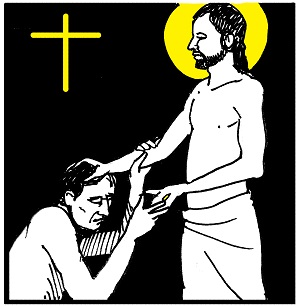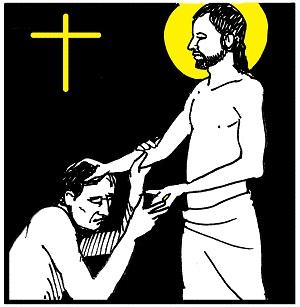

“Do not be unbelieving, but believe!” (John 20:27).
Second Sunday of Easter, Divine Mercy.
Acts 4:32-35; Ps 118; 1 John 5:1-6; John 20:19-31
The story of Thomas coming to faith in the risen Jesus is both a theophany and an encounter with the Incarnation. Jesus is both the crucified one and our LORD and God.
The body of Jesus of Nazareth is the complete record of his brief human life and his brutal death. Even in glory, his wounds remain as the astonishing story of his human sojourn. The same feet that walked the roads of Galilee and Judea, were wept over and anointed by the women, are now and forever pierced. The same hands that touched the sick and broke bread with the disciples are distended and pierced from the trauma of hanging on the cross. His side is an open wound from the spear thrust into his heart to confirm he was dead, so they did not need to break his legs to hasten it.
This is what glory looks like from the human side of history, what El Salvador‘s Monsignor Romero displayed when a bullet exploded in his chest and knocked him to the floor behind the altar, his blood mixing with the spilled chalice and scattered hosts. This is the witness of all the martyrs and also judgment on those who torture and kill the innocent. But from the other side of history, where God sees and we are invited to stand in awe, this is the triumph of love over death. This reveals God’s mercy poured out on a sinful world still blind to the grace of divine forgiveness. Jesus breathes Easter shalom into his human brothers, recreating them to be ambassadors of the reconciliation they themselves needed and now can preach.
Thomas moves from doubt to faith when he meets both sides of history in the crucified and risen Jesus standing before him in the locked upper room, inviting him to touch his wounds and see the transformation they won for all humanity, freedom from death and eternal life with God. Thomas falls to his knees and worships the mystery of our salvation; “My LORD and my God.”
The author of the fourth Gospel holds together the human and divine Jesus to make true what is written to the churches in 1 John 1:
That which was from the beginning, which we have heard, which we have seen with our eyes, which we have looked at and our hands have touched—this we proclaim concerning the Word of life. The life appeared; we have seen it and testify to it, and we proclaim to you the eternal life, which was with the Father and has appeared to us. We proclaim to you what we have seen and heard, so that you also may have fellowship with us. And our fellowship is with the Father and with his Son, Jesus Christ. We write this to make our joy complete.
Our bodies, too, will record our lives, the full story of our hands and feet and every act of love we performed. This is our passport to eternity through the wounds of Christ into the Body of the baptized, where our joy will be complete. Blessed are those who believe, for they shall find life.
Advertisement








